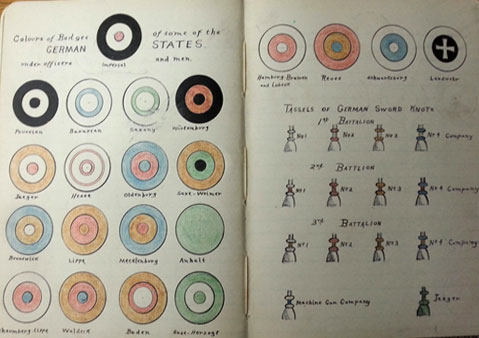 Today I decided to revisit a manuscript notebook that I first came across over the summer, when we initially acquired it. The Howard W. Robbins diary is a WWI notebook (1917-1918) which features 88 pages of handwritten notes, diagrams, formulas, and reports including the above illustrations of the various “Colours of Badges of some of the German States,” and the “Tassels of German Sword Knots.”
Today I decided to revisit a manuscript notebook that I first came across over the summer, when we initially acquired it. The Howard W. Robbins diary is a WWI notebook (1917-1918) which features 88 pages of handwritten notes, diagrams, formulas, and reports including the above illustrations of the various “Colours of Badges of some of the German States,” and the “Tassels of German Sword Knots.”
Robbins was a first Lieutenant in the 104th Infantry of the U.S. army, and his notebook features advice on a variety of topics, including Patrolling and Scouting, which, Robbins writes “is a great protection from surprise, serves to keep up the morale of our own troops, and tends to lower that of the enemies!” Robbins even includes a diagram for training soldiers in patrolling and scouting.
One of the most interesting aspects of Robbins’ notebook is his writings about the use of various military technologies, including Telescopes, the Prismatic Compass, Thermometer Targets, and even Aeroplane Photographs, or the taking of photographs from the air. This would have been an especially important new technology, as WWI was one of the first military conflicts to utilize powered aircraft. Robbins notes that those who take photos from the air are “men of special aptitude, as for instance artists, painters, architects, and so forth.” He also writes about how these photos help officers to identify German trenches, as well as Posts and Company Headquarters.
The notebook is filled with a variety of information on many different topics and could be a valuable and engaging primary source for anyone interested in WWI, or the development of military technologies and strategies.
Discover this and other interesting primary sources Tuesdays, Wednesdays, and Thursdays from 1:00-3:00 p.m. in the Archives & Special Collections on the second floor of the Library!
By Kara Flynn

